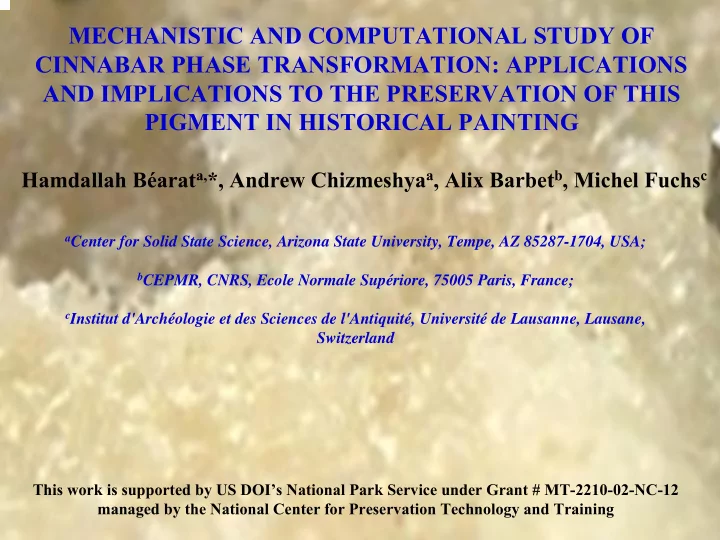

MECHANISTIC AND COMPUTATIONAL STUDY OF CINNABAR PHASE TRANSFORMATION: APPLICATIONS AND IMPLICATIONS TO THE PRESERVATION OF THIS PIGMENT IN HISTORICAL PAINTING Hamdallah Béarat a, *, Andrew Chizmeshya a , Alix Barbet b , Michel Fuchs c a Center for Solid State Science, Arizona State University, Tempe, AZ 85287-1704, USA; b CEPMR, CNRS, Ecole Normale Supériore, 75005 Paris, France; c Institut d'Archéologie et des Sciences de l'Antiquité, Université de Lausanne, Lausane, Switzerland This work is supported by US DOI’s National Park Service under Grant # MT-2210-02-NC-12 managed by the National Center for Preservation Technology and Training
CINNABAR OR VERMILION IN ANTIQUITY ■ In general: -What is cinnabar? Mercuric sulfide: α -HgS -Terminology (cinnabar & minium) -Origin (natural & synthetic) -Use (pigment, ink, preservative, cosmetics, rituals) ■ As a pigment -Significance (socio-economic and artistic) -Technology (extraction & application)
What is the cinnabar problem? The blackening!
Structural models of HgS phases: cinnabar (left) and metacinnabar (right). The metacinnabar structure is given here in terms of a tripled cell (3C setting) of the conventional cubic structure (a=5.852 Å). The equivalent hexagonal cell has a H =a / √ 2 and c H = a √ 3. α -HgS β -HgS 2 3
Table 1: List of raw samples studied with their origin, phase composition, and structural data obtained by XRD and cell refinement.
X-ray powder diffraction patterns for the the raw samples. While all cinnabar ( α - HgS) samples are phase pure, both synthetic and natural metacinnabar ( β - HgS) contain some cinnabar as phase impurity (reflections indicated with red triangles). 10000 8000 6000 C ounts β -HgS (Mt. Diablo, USA) β -HgS (Synthetic) 4000 α -HgS (Spain, ground in air) α -HgS (Spain, ground under ac.) 2000 α -HgS (Ukraine, Single crystal) α -HgS (Synthetic) 0 10 20 30 40 50 60 70 2 Theta (°)
Raman spectrum obtained for Raman spectrum obtained for cinnabar metacinnabar ( β -HgS) polycrystalline ( α -HgS) single crystal from Ukrania material from Mont Diablo, CA, USA using a green laser of λ =540 nm. using a green laser of λ =540 nm. 350 250 2000 171 300 1600 250 Counts Counts 1200 200 285 950 348 285 800 150 400 100 150 250 350 450 550 650 750 100 300 500 700 900 1100 1300 1500 Wavenumber (cm-1) Wavenumber (cm-1)
Blackening of cinnabar Effect of lasers and electrons a 5 µ b c
Cathodoluminescence spectra of (a) single crystal cinnabar from Ukraine, (b) polycrystalline metacinnabar from CA, USA., 200 600 a b 585nm 150 400 C ounts Counts 100 200 50 0 0 500 540 580 620 660 700 200 300 400 500 600 700 800 Wavelength (nm) Wavelength (nm)
Effect of Grinding & heat treatment (a) Single crystal cinnabar from Ukraine ground in air and (b) same sample after heat treatment at 100°C in air. Polycrystalline cinnabar from Spain, (c) ground under acetone, (d) ground in air, and (e) same sample in (d) after heat treatment at 100°C in air. a c 1mm 1mm b d e 1mm 1mm 1mm
Raman & cathodoluminescencfe of blackened cinnabar a 200 (a) Micro-Raman spectra of 150 Intensity 1min blackened cinnabar obtained 100 2 min by grinding cinnabar from 3 min 50 Spain in air after 1, 2, and 3 minutes of exposure to the 0 laser 100 200 300 400 500 600 700 Wavenumber (cm-1) 3000 b 350nm 625nm (b) cathodoluminescence 2000 spectrum of the same sample C o u n ts with CL images of the zones 1000 emitting in the UV (350nm) 0 and in the red-orange 200 300 400 500 600 700 800 900 (625nm). Wavelength (nm)
Effect of sunlight on the color of cinnabar paint films prepared with different media, exposed to direct Arizona sunlight for 8 months. Ca(OH) 2 sol Beeswax Water 2mm 2mm 2mm Vaseline Linseed Oil Tempera 2mm 2mm 2mm
Amorphization gradiant of cinnabar as a function of distance from the edge. Images a- d correspond to points a-d in image e. Pigment was prepared in water and exposed to Phoenix, Arizona sunlight for 8 months. Images a-d were obtained using a Hitachi 4700 Field Emission Scanning Electron Microscope (FESEM). c b a e d d c b a ● ● ● ● 2mm
Comparison of XRD spectra of the red and black zones in the previous plate. The reflection given here is (104) of cinnabar. Note the shift of the d-spacing of this plane toward a higher value, which is closer to that of metacinnabar (2.92Å). 1800 1500 1200 Intensity 900 600 300 ∆ d 102 = 0.004Å 0 2.9 2.88 2.86 2.84 2.82 d- spacing (Å)
Table 2: Chemical composition (expressed in atomic %) of a black spot caused by irradiation with electrons (15KV, 10mA) as compared to that of a fresh zone. Fresh Zone Irradiated Zone Hg (Atomic %) 45.80 50.83 S (Atomic %) 54.20 49.17 Hg/S Ratio 1.03 0.85 % Sulfur 0 18.26 Deficiency
CONCLUDING REMARKS - Blackening of cinnabar is a physico-chemical & structural transformation process which is complex, but quite reversible. - Several factors can induce the blackening of the pigment such as the radiation (electrons, lasers, sunlight) and by mechanical activation/amorphization. - The blackening cannot be attributed to the formation of cubic metacinnabar, as very often speculated, but to an intermediate and amorphous phase. This was evidenced by the broadening of the XRD reflections, splitting of the band gap of the product, and by the SEM imaging. - SEM images also show that the amorphous product forms a passivating layer around the cinnabar grains/crystals that may inhibit further transformation, and which is consistent with the observations made on historical samples. - The red vermilion color can be restored by moderate thermal treatment of the blackened pigment in air. Further work is still required to validate this statement.
Recommend
More recommend